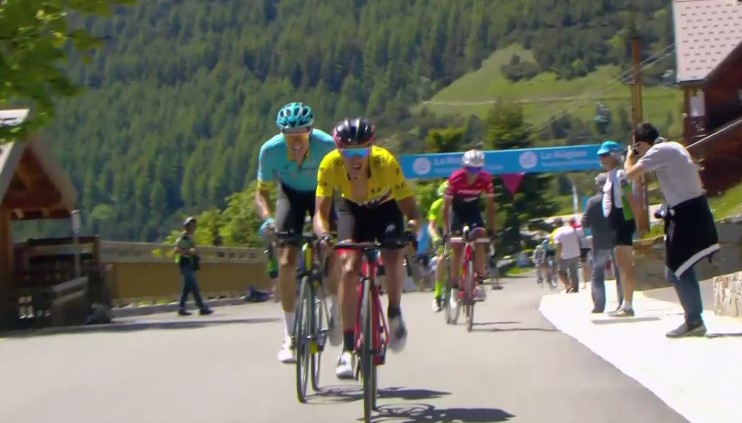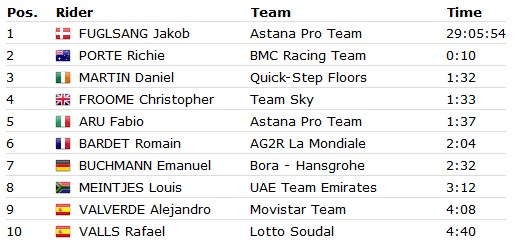
It was a classic edition of the eight-stage race I like to call The Dolphin – but as ever, the main point of interest is what events told us about the form of the main contenders for the Tour de France, which starts in three weeks.
The strongest rider
An oddly worded subheading in that the winner, Jakob Fuglsang of Denmark, probably wasn’t the strongest rider in the race (although he was very impressive). The strongest rider was almost certainly the perennially tetchy Australian, Richie Porte.
Despite being so small that his head sometimes looks bigger than his body, Porte won the time trial. When a small guy has the power to win a time trial, you tend to think that gravity will only magnify his advantage.
So it proved. On stage six – the first foray into the mountains – he finished second as part of a four-rider front group. On stage seven, he went for the old riding-faster-than-anyone-else-can ploy to distance every rival bar Fuglsang.
So how did Porte manage to avoid winning?
Richie Porte wouldn’t be Richie Porte if he didn’t have at least one day where everything goes horribly wrong. It’s his thing.
On this occasion it wasn’t particularly his fault. He was just unfortunate to find himself in the overall lead on one of those short mountain stages where everything goes mental on the very first climb. About 90 per cent of the peloton was ditched within the first half-hour and the poor lad very quickly found himself in an Everyone v Richie Porte scenario. While he performed more than creditably, those ain’t good odds.
None of Porte’s rivals were willing to chase any of the other contenders if Porte – the man with most to lose – was in the same group as them. Identifying that this was a pretty good way to break him, they took it in turns to attack, forcing Porte into a constant chase and denying him the benefit of the old ‘it’s easier to cycle behind someone else‘ rule.
Unsurprisingly, Porte got tired. Speaking after the race, his innate grumpiness outweighed an attempt at phlegmatism.
“We learnt a lesson today, but there’s good signs for July that I’m climbing well and that teams want to gang up on me to put me out of the race. That’s their strategy. I can’t say that they were trying to win the race but trying to make me lose the race perhaps. C’est la vie.”
Having detached the Australian from the group, everyone then did exactly the same thing to Froome, encouraging the notion that maybe they were just ganging up on whoever was most likely to win.
Summary – Stage 8 – Critérium du Dauphiné 2017 by tourdefrance
Jakob Fuglsang
The overall winner isn’t one of the big names in cycling – a seventh place in the 2013 Tour de France was arguably his highest profile result before now.
However, Fuglsang’s relative lack of results doesn’t really reflect how good he is. The truth is he’s very rarely ridden for himself before now. He’s generally deployed as the strongest donkey in support of someone else, a role which necessitates a certain amount of soft pedalling on non-key stages so as to preserve his strength for when he’s needed.
After this result, there’s talk that the Dane might be a stronger rider than Astana’s nominal leader, Fabio Aru, and may therefore be promoted from top donkey to top dog for the Tour. However, this seems to me to rather overlook the very mechanism by which he won this race: his team had two riders in the mix.
There was only one major contender who didn’t have to do any real chasing on the final stage and that was Fuglsang because one of the two men up front at the business end of the race was his team-mate. When Aru was eventually reeled in, Fuglsang was freshest and he duly won.
That’s the way to go at the Tour, I reckon.
Chris Froome and all them
Froome’s fourth place looks duff, but if he folded on the final day, that was probably only because he’d unleashed more attacks inside a couple of hours than he normally manages in an entire three-week race.
More worrying was his time trial form. Normally one of his biggest advantages over his tinier rivals, on this occasion he finished behind Porte, Alejandro Valverde and Alberto Contador.
But here we arrive at the nub of the Criterium du Dolphin and an observation that negates almost all of what I’ve just written: no-one really knows what any of these guys have been doing leading up to this race.
For example, Alberto Contador has said that he’s trying to stay fresh for the Tour and has been taking his training fairly easy this year. While this means he might not be so sharp in the first week, the idea is that he’ll be less tired in the third week.
Similarly, for all we know Froome had done two solid weeks of training leading up to the Dolphin and arrived for the race semi-cream-crackered. If he has a bit of a rest now, maybe he’ll turn up for the main event in better shape than Porte.
So, in summary, we don’t really know anything about the form of the main contenders for this year’s Tour de France. Fortunately, a more telling examination of their capabilities will commence on July 1 in the form of a race called the Tour de France.

Leave a Reply